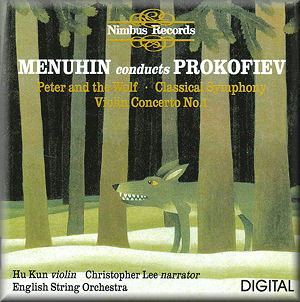 |
 |
| 
Buy
through MusicWeb
for £12 postage paid World-wide.
Musicweb
Purchase button
Sound Samples and Downloads |
Sergei PROKOFIEV
(1891-1953)
Peter and the Wolf – a musical tale for children, Op.67 (1936)
[27:45]
Symphony No.1 in D major, Classical, Op.25 (1917) [14:12]
Violin Concerto No.1 in D major, Op.19 (1917) [21:08]
 Hu Kun (violin), Christopher Lee (narrator)
Hu Kun (violin), Christopher Lee (narrator)
English Chamber Orchestra/Yehudi Menuhin
rec. May 1989, Leominster Priory
 NIMBUS NI 5192 [63:21]
NIMBUS NI 5192 [63:21] 
|
|
|
†
Peter and the Wolf, Prokofiev’s evergreen children’s
classic, never loses its charm and appeal. It is truly a tale
“for children young and old”. The story is simple, and we know
that all will end well, yet every time it stirs the imagination.
As you probably know, each character is represented by a theme
and a musical instrument, and so the young listeners learn the
different orchestral voices. The coupling with the much more
modern Violin Concerto No.1 is not very intuitive: what
is the supposed audience for this disc? Putting Peter and
the Wolf with Saint-SaŽns’ Carnival of Animals and
Britten’s Young Person’s Guide to the Orchestra would
have been more natural. I used to like the recording by Eugene
Ormandy on Sony, in exactly this combination, but when I returned
to it after hearing Menuhin, it seemed tame and too civilized
in comparison.
†
Christopher Lee is a narrator par excellence, though
his voice is too recognizable to avoid associations with his
other roles. Anyway, he knows how to hold the listener’s attention.
The orchestra plays with all the heart and the music blossoms.
The tempi and the dynamics are alive and flexible, and there
is vivid enthusiasm. The Wolf’s music is indeed scary, with
Wagnerian undertones. I don’t remember ever having such a feeling
with other performances. The ferocious joy of the hunters’ march,
their rumbling shots, Peter’s carefree bravery, the panic of
the Duck and the excitement of the Bird – everything is so embossed.
The pomp of the triumphal procession will keep you stomping
your feet. The recording is generously spacious.
†
The Classical Symphony is a unique creation. The form
might be inherited from Haydn, but the contents are fresh and
modern. There exist recordings that sound lighter and crisp;
some are more swift and mercurial. This one has more power;
its colors are deeper. Menuhin presents it as a genuine, full-scale
symphony, not just a cool curiosity. Do not worry: he does not
make it deadly serious! All the fun is there, and it is in fact
more pronounced, due to the stronger accents he applies.
†
The first movement has the drive of a rolling train. Yet this
is a festive train that shines and glitters, with sparkling
gold and party crackers! The tuttis sound like elephants
blaring happily. The slow movement is very Haydnesque, its character
cheerful yet calm. It is marked Larghetto, but Menuhin
takes it as an Andante. In this way it receives more
urgency and some mild tongue-in-cheek feeling. The Gavotte
is weird and charming. The reading is not hurried, and is expressive
and well-articulated, as if it were accompanying a ballet. The
finale is swift and sparkling. The orchestral playing is transparent,
with all lines and layers clearly visible. The ensemble is light
and tight-knit. The performance is characterized by bold accents
and full dynamic contrasts. On the whole, I think this is a
splendid interpretation.
†
In the first movement of Prokofiev’s First Violin Concerto,
much is going on in the stratospheric heights. The music has
fragrant lyrical blossom – at some moments it almost seems to
morph into the slow movement of Saint-SaŽns Third! The soloist
Hu Kun does well in phrasing Prokofiev’s long lines. The orchestra
is lucid and dainty, with excellent contributions from the woodwind
players. The ending is magical. Menuhin applies no pressure,
but still keeps the colors bright and saturated.
†
The middle movement is an energetic Scherzo with many
modern elements. Hu Kun and the ESO players fly through it effortlessly.
The finale starts with cautious angularity, like some sweetened
Shostakovich - who was just 11 at the time of its creation.
But then the apollonian personality of the composer shines through,
and we can recognize the creator of the most fairytale pages
of Cinderella. Actually, one can glimpse the entire ballet
in this movement, like an oak in an acorn. The voice of Hu Kun’s
violin is not thin as, for example, in the Bell-Dutoit recording.
The ending returns us to the main theme of the first movement
– another magical page that melts into dreamy radiance. Georges
Auric condemned the traces of “Mendelssohnism” in this concerto
– and indeed, there is some in the flowing lyricism of the outer
movements and the elfin lightness of the Scherzo. Unlike
Auric, I don’t think it’s a bad thing at all! Again, this may
not be the most powerful reading but it is very lyrical.
†
This is an excellent document of Menuhin’s conducting prowess.
The three works receive royal treatment, and from now on this
will probably be my Classical Symphony of choice. The
recorded sound is warm and inviting. The liner-note (English
only) contains a fine essay on the works, which actually manages
to tell us something beyond the customary information. Nothing
is said there about the performers, though, and that’s a pity.
†
Oleg Ledeniov
†
|
|

